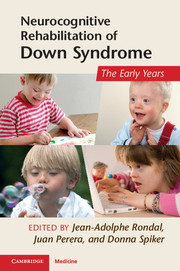Book contents
- Frontmatter
- Contents
- List of contributors
- Preface
- Acknowledgments
- Section 1 Definition, history, methodology, and assessment
- Section 2 Genetics, brain, and animal models
- Section 3 Pharmacological and medical management and treatment
- Section 4 Early development and intervention
- 10 Developmental models as frameworks for early intervention with children with Down syndrome
- 11 Aspects of motor development in Down syndrome
- 12 Memory development and learning
- 13 Prelinguistic and early development, stimulation, and training in children with Down syndrome
- 14 Speech perception, stimulation, and phonological development
- 15 Goal-directedness as a target for early intervention in Down syndrome
- 16 The role of parents of children with Down syndrome and other disabilities in early intervention
- Section 5 Therapeutic perspectives
- Conclusions
- Index
- References
10 - Developmental models as frameworks for early intervention with children with Down syndrome
Published online by Cambridge University Press: 05 July 2011
- Frontmatter
- Contents
- List of contributors
- Preface
- Acknowledgments
- Section 1 Definition, history, methodology, and assessment
- Section 2 Genetics, brain, and animal models
- Section 3 Pharmacological and medical management and treatment
- Section 4 Early development and intervention
- 10 Developmental models as frameworks for early intervention with children with Down syndrome
- 11 Aspects of motor development in Down syndrome
- 12 Memory development and learning
- 13 Prelinguistic and early development, stimulation, and training in children with Down syndrome
- 14 Speech perception, stimulation, and phonological development
- 15 Goal-directedness as a target for early intervention in Down syndrome
- 16 The role of parents of children with Down syndrome and other disabilities in early intervention
- Section 5 Therapeutic perspectives
- Conclusions
- Index
- References
Summary
Our contribution to this book is the outline of a developmental approach that can be used to guide early intervention for individuals with Down syndrome (DS). For this task, we come fortified with frameworks, models, and paradigms from general developmental theory and research to guide our perspective on intervention. With this background and these resources, we suggest a universal context that is premised on the overwhelming similarities in underlying developmental processes that are observed among children, regardless of disability, and ability levels or individual experiences, as a first step to understanding intervention for children with DS from as early as birth and how it can be impacted by various direct and indirect factors (Hodapp & Burack, 1990). The emphasis on the commonalities of development does not obscure the obvious and important differences across etiologies, families, and individuals, but rather provides a framework of the whole child within which these differences can be discussed and understood (Zigler, 1967, 1969; Hodapp et al., 1990). Contemporary developmentalists celebrate differences at all levels of the human experience as essential, but not sole contributors, to developmental outcomes and behavior. Thus, the extensive understanding of universal trajectories of development and the ways that they are maintained or affected by cultural, societal, communal, familial, and individual differences is an organizing framework for understanding the relevance of the family, the individual, and outside influences to positive outcomes for children with DS (Hodapp, 1990; Hodapp & Burack, 2006).
- Type
- Chapter
- Information
- Neurocognitive Rehabilitation of Down SyndromeEarly Years, pp. 142 - 152Publisher: Cambridge University PressPrint publication year: 2011
References
- 1
- Cited by



